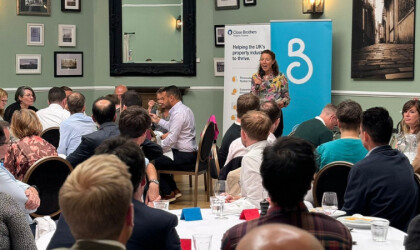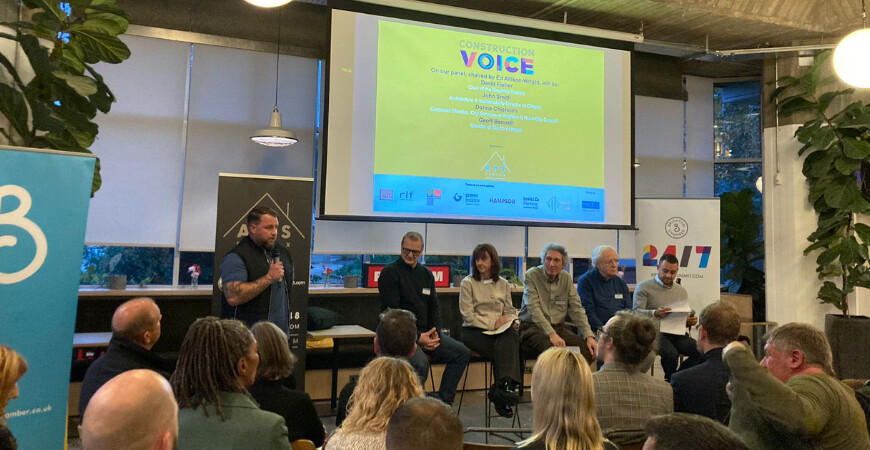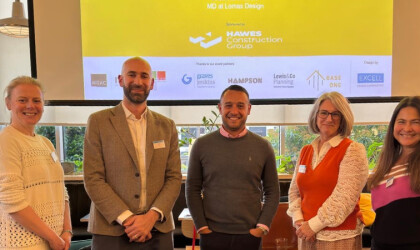

Fri 18 / 10 / 24
Construction Voice: The role of heritage in Brighton & Hove's evolution
By Flo Powell, Joint Managing Director of Midnight, B Corp PR agency with a wealth of experience in the built environment.
By Flo Powell of Midnight Communications
On 14th October, PLATF9RM in Hove played host to Brighton Chamber's latest Construction Voice event, exploring into an ever-important topic for our city: The Role of Heritage and the Evolution of Brighton & Hove. With panellists representing both public and private sectors, the discussion explored the delicate balance between preserving heritage assets and embracing modern development in a city brimming with historical character.
Moderated by Ed Allison-Wright, the panel was comprised of key voices in the industry, including David Fisher (Chair of the Regency Society), John Smith (Architecture & Sustainability Director at Cityzen), Donna Chisholm (Corporate Director, City Services at Brighton & Hove City Council), and Geoff Bennett (Director at Studio Astragal – formerly of Brighton & Hove City Council Conservation Team).
A city shaped by constraints and opportunities
Brighton & Hove's unique position, sandwiched between the South Downs and the sea, makes it an architecturally and geographically challenging area for development. The city boasts an impressive array of heritage assets, from the grandeur of the Royal Pavilion to lesser-known gems tucked away in its conservation areas. However, as Ed Allison-Wright pointed out in his introduction, this constrained geography also forces us to be creative with brownfield development. It raises the question: how do we ensure heritage plays a meaningful role in the city’s continued evolution?
What do we mean by heritage?
Donna Chisholm from Brighton & Hove City Council opened with a compelling perspective on heritage as a "living, breathing thing." She stressed that heritage should not be viewed as something static, fixed in time, but as something that must evolve to remain viable. Buildings need to serve a purpose, whether as homes, workplaces, or cultural hubs. The challenge, Donna suggested, is to balance preservation with the need for modernisation, acknowledging that some buildings might not stand the test of time—or, indeed, should not.
This led to an interesting reflection on the city’s relationship with its iconic buildings. Donna posed a provocative question: Will the Brighton Centre, one of the city’s most prominent modern structures, be listed in 50 years? The idea was met with laughter from the audience, but it sparked a deeper conversation about what constitutes heritage. After all, today’s unassuming or even controversial buildings could be tomorrow’s cherished landmarks.
The importance of research
From the private sector perspective, Geoff Bennett spoke about the necessity of thorough research when dealing with heritage buildings. He emphasised the importance of understanding the layers of a building’s history before any conservation or development work can begin. In contrast to local government, which often lacks the resources for in-depth research, private firms like his can invest time in uncovering the full story of a heritage asset. Geoff shared anecdotes from his own work on some of the city’s most recognisable buildings, including Brighton Station and the Grand Hotel. His perspective highlighted a key issue in heritage conservation: the need for collaboration between the public and private sectors to protect and restore these assets for future generations.
Balancing modernisation with heritage
The panel also touched on the technical challenges of retrofitting heritage buildings to meet modern environmental standards. John Smith of Cityzen pointed out the complexities of bringing older buildings up to scratch in terms of energy efficiency. Loft insulation, draught-proofing and the reconditioning of sash windows are all feasible, but when it comes to larger structural changes, such as insulating walls or installing solar panels, the challenges multiply. Listed buildings, by their nature, are bound by strict regulations, which makes finding the right balance between conservation and modernisation a difficult—but not impossible—task.
John’s comments echoed a broader concern that had been raised by panellists throughout the evening: How can we ensure that heritage assets remain relevant and sustainable in the face of climate change? Brighton has already experienced the impacts of extreme weather, with floods in the 1990s and storms that have damaged conservation areas. As Geoff pointed out, the effects of global warming will only make this balancing act more precarious.
The skills challenge
One recurring theme throughout the discussion was the decline of skilled labour in heritage conservation. John noted that younger generations are gravitating towards new-build sites and modern construction methods, leaving a shortage of specialists in areas like fibrous moulding and working with lime. This presents a significant threat to the preservation of Brighton’s architectural history, and the sector as a whole, as fewer workers are trained to maintain and restore these complex structures.
Public perception and the value of heritage
Another thought-provoking discussion revolved around public perception of heritage. David Fisher from the Regency Society noted the imbalance in Brighton’s listed buildings, with a significant portion dating back to just one decade in the 1820s. He highlighted that heritage, by its nature, is subjective. What we value today may not be considered significant in the future. Similarly, what is dismissed as "distressingly monotonous" in one era may become a highly prized asset in another.
The conversation turned towards the concept of beauty, with a question from the audience (Geri Silverstone) asking why it hadn’t been mentioned more explicitly. Donna responded by noting that beauty is subjective, and while it plays a role in heritage discussions, it isn’t the primary criterion for listing a building. Geoff expanded on this, noting that while Victorian architecture was once derided, it is now highly valued for its aesthetics and historical significance.
The future of Brighton’s heritage
As the evening drew to a close, the panel reflected on the future of Brighton’s built heritage. Geoff Bennett shared his memories of the city’s decline in the 1970s and 80s when many of its properties were derelict and in disrepair. However, thanks to a series of grants and conservation programmes, much of the city’s architectural character was restored, attracting private investment and revitalising the area.
The question now is whether such a programme could be repeated in today’s economic climate. Donna expressed the desire for more resources to support heritage conservation but acknowledged the financial pressures facing the council after years of budget cuts. Without significant national investment, she argued, it will be difficult to maintain the city’s vast array of heritage buildings.
A city at a crossroads
The evening’s discussions left the audience with a sense that Brighton & Hove is at a crossroads. On the one hand, the city’s rich architectural heritage is a key part of its identity and appeal. On the other hand, the pressures of modernisation, climate change, and economic constraints are forcing difficult decisions about which buildings to preserve and how to do so.
Ultimately, the future of Brighton & Hove’s heritage will depend on a delicate balancing act between preservation and progress, between the public and private sectors, and between the past and the future. As the city continues to evolve, its heritage must evolve with it—ensuring that the character and history of Brighton & Hove remain integral to its future.
Brighton Chamber's next Construction Voice social will take place on 11 December. Stay tuned for more details.
With special thanks to our event sponsor, APS Sussex.
With thanks to Flo Powell for a brilliant writeup of the panel discussion. Find out more about Midnight on their website here.
Explore previous Construction Voice events on the Chamber website below - and head to the Chamber event calendar to see what's planned next.
If you want to contribute to the Chamber blog, contact us on hannah@brightonchamber.co.uk



